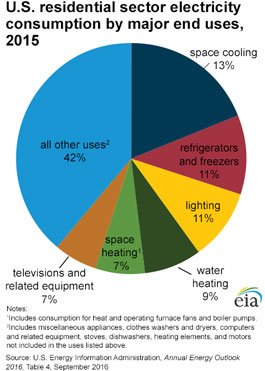Did you know?
Electricity was first sold in the United States in 1879 by the California Electric Light Company in San Francisco, which produced and sold only enough electricity to power 21 electric lights (Brush arc light lamps).
Electricity consumption in the United States totaled about 3.86 trillion kilowatthours (kWh) in 2015
Electricity is an essential part of modern life and important to the U.S. economy. People use electricity for lighting, heating, cooling, refrigeration, and for operating appliances, computers, electronics, machinery, and public transportation systems. Electricity use in the United States in 2015 was more than 13 times greater than electricity use in 1950.
Total electricity consumption includes retail sales of electricity to consumers and direct use electricity. Direct use electricity is produced and used by consumers. The industrial sector generates and uses nearly all of the direct use electricity. In 2015, retail sales of electricity were 96% of total electricity consumption, or about 3.72 trillion kWh. Direct use electricity was about 4% of total electricity consumption, or about 0.14 trillion kWh.
Shares of total U.S. retail sales of electricity use by consuming sectors in 2015:
- Residential—38%
- Commercial—36%
- Industrial—26%
- Transportation—0.2% (mostly by public transit systems)
Cooling is the single largest use of electricity by the U.S. residential sector
The U.S. Energy Information Administration (EIA) estimates that space cooling (air conditioning) was the single largest use of electricity by the U.S. residential sector in 2015, followed by refrigeration, lighting, water heating, space heating, and televisions and related electronic equipment. The combined use by clothes washers and dryers, computers and related equipment, dishwashers, small appliances, and other electrical equipment was about 40% of total U.S. residential sector electricity use.
Lighting is the single largest annual use of electricity in the U.S. commercial sector
Lighting is the largest use of electricity in the U.S. commercial sector, which includes retail, office, education, institutional, public, and government buildings, and outdoor and public street lighting. The other major commercial uses of electricity are for ventilation, cooling, refrigeration, powering computers and other office equipment, and space and water heating. Other uses of electricity in this sector include powering medical, security, and fire suppression equipment; powering elevators and escalators; and running cooking and laundry equipment.
Machine drives are the largest use of electricity by U.S. manufacturers
About half of electricity that U.S. manufacturers use is for operating machinery. Process and boiler heating is the next largest use of electricity at about 13%. Use of electricity for lighting is about 7%.
Electricity use in the United States is projected to grow slowly
Electricity consumption in the United States declined in only three years between 1950 and 2007. However, it declined in five of the years from 2008 to 2015, with the largest drop (about 4%) occurring in 2009. One contributing factor to the drop in electricity consumption was the economic downturn in late 2007 through 2009. The economic downturn led to a large drop in electricity sales to the industrial sector. Other factors, such as efficiency improvements associated with new appliance standards in the buildings sectors and overall improvements in the efficiency of technologies powered by electricity, have slowed electricity demand growth and may contribute to slower future growth. In the Annual Energy Outlook 2016, Reference case, total U.S. electricity use grows by an average of less than 1% per year from 2014 to 2040.
World electricity use may grow fastest in non-OECD countries
The member countries of the Organization for Economic Cooperation and Development (OECD) consumed about 48% of the world's total electricity supply in 2012. In the International Energy Outlook 2016, OECD nations' share of world electricity use is projected to be 39% in 2040.






